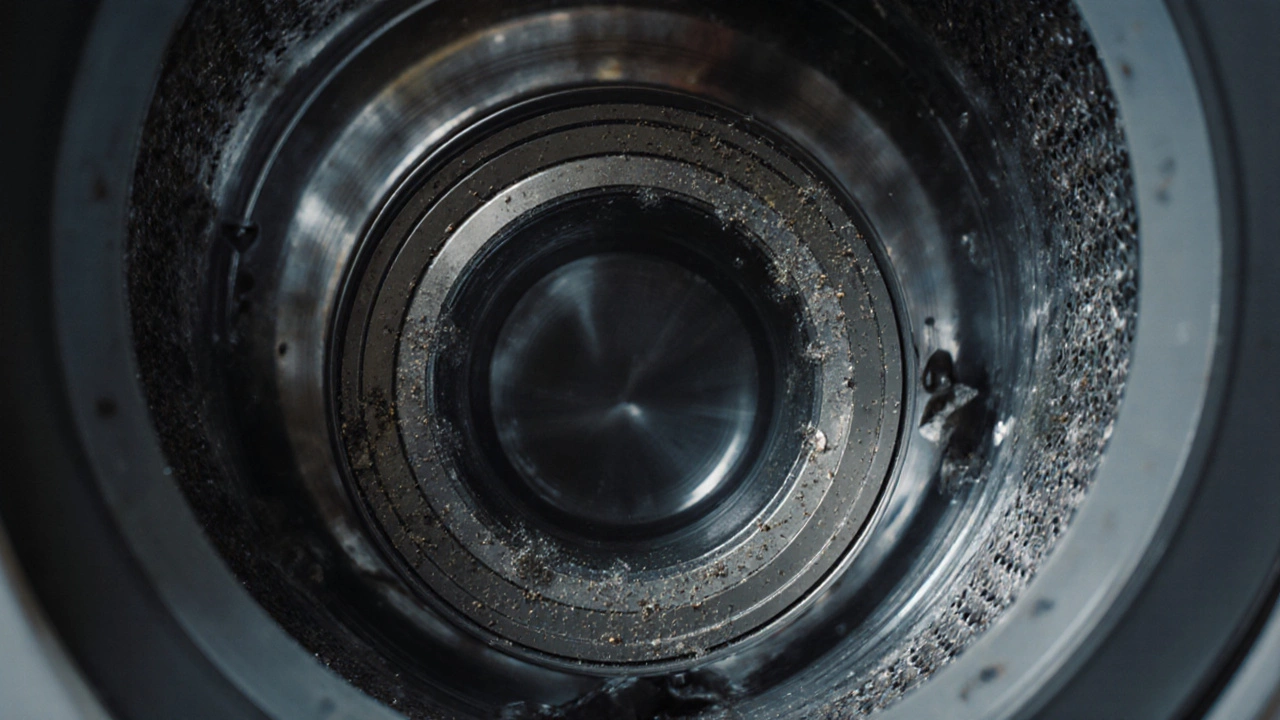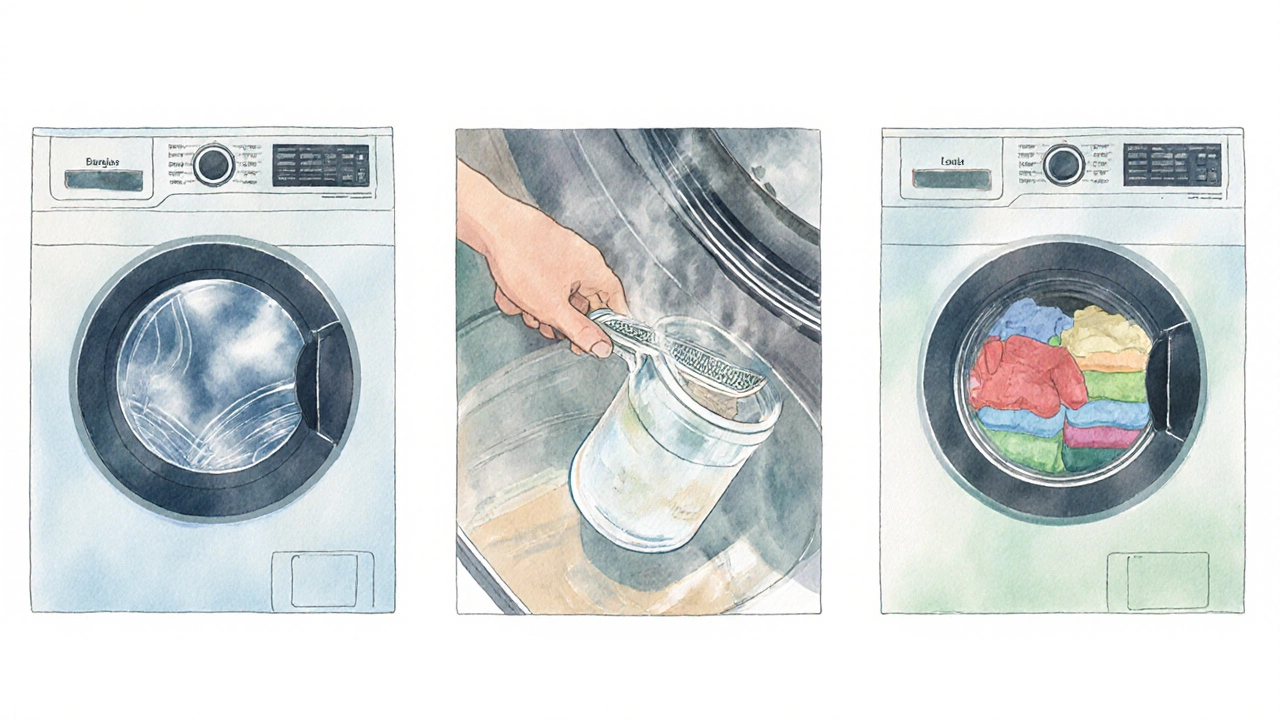
- 18 Oct 2025
- Gideon Thornton
- 0
Washing Machine Failure Diagnostic Tool
Identify Your Washing Machine Issue
Select the symptoms you're experiencing to diagnose the most likely failure type.
Most Likely Failure Type
Estimated Repair Cost
£150 - £300
Recommended Actions
- 1. Stop using the machine immediately - Continued use may cause further damage.
- 2. Check for water leaks - If leaking, place towels around the base.
- 3. Call a professional technician - Drum bearing replacement requires special tools.
- 4. Prevent future issues - Regularly clean the pump filter and avoid overloading.
When your laundry pileup keeps growing and the machine starts making strange noises or leaks, you instantly wonder: what is the most common washing machine failure? The answer isn’t a mystery - it’s usually a worn‑out drum bearing. Knowing why this happens, how to spot it early, and what you can do before calling a pro can save you time, money, and the hassle of a soggy basement.
How a Washing Machine Works - The Core Parts
Before diving into failure modes, it helps to understand the basic moving parts. A typical front‑loading or top‑loading Washing machine is a household appliance that combines water, detergent, and mechanical agitation to clean fabrics consists of:
- Drum - the tub that holds the clothes.
- Drum bearing - supports the drum’s rotation and absorbs vibration.
- Motor - powers the drum’s spin and agitation.
- Water inlet valve - controls the flow of hot and cold water into the machine.
- Pump - expels water during the drain cycle.
- Door lock (or lid switch) - ensures the door stays sealed during operation.
- Control board - interprets user settings and coordinates the cycle.
Each component is designed to endure hundreds of cycles a year, but wear and tear are inevitable. When one part gives out, the whole system can fail.
Most Common Failure: Drum Bearing Wear
The drum bearing is the unsung hero that lets the drum spin smoothly. Over time, water, detergent residue, and even tiny metal particles form a gritty slurry that erodes the bearing’s lubricating oil. The result? A loud rumbling or grinding noise, excessive vibration, and eventually the drum can seize.
washing machine failure is often first noticed during the spin cycle when the bearing’s resistance peaks. The symptoms include:
- Deep, metallic grinding noise that grows louder each cycle.
- Visible shaking of the machine, especially on higher spins.
- Water leaking from the bottom because the seal around the bearing has cracked.
- In severe cases, the drum won’t turn at all.
Because the bearing is located behind the tub, replacement usually requires removing the back panel, draining the drum, and pulling the drum out of its housing - a job best left to a qualified technician unless you’re comfortable with heavy lifting and basic tools.
Other Frequent Failures You’ll Encounter
Motor Trouble
The Motor converts electrical energy into mechanical rotation to drive the drum and pump can overheat or its brushes can wear down. Common signs are:
- Intermittent failure to start during a cycle.
- Burnt smell or scorching sound.
- Cycle stops mid‑wash.
Motor issues often require a professional’s diagnostic tools, as the motor is electrically linked to the control board.
Water Inlet Valve Failure
The Water inlet valve regulates the amount of water entering the washing machine is prone to clogging from mineral deposits or fault from the solenoid. Symptoms:
- Machine takes too long to fill or never fills.
- Leaking water from the back front of the unit.
- Error codes related to “fill” on the display.
Cleaning or replacing the valve is a moderate DIY task: turn off water supply, detach the hoses, and replace the valve assembly.
Pump Problems
The Pump removes water from the drum during drain and spin cycles can get blocked by lint, coins, or small garments. Look for:
- Water left at the bottom after a spin.
- Buzzing sound without water movement.
- Foul odor coming from the pump area.
Removing the pump filter and clearing debris often resolves the issue, but a damaged impeller will need a swap.
Door Lock / Lid Switch Fault
The Door lock prevents the door from opening while the drum is rotating can malfunction, especially on front‑loaders. Typical signs:
- Machine refuses to start, displaying “door lock error”.
- Door pops open during a cycle.
- Intermittent error that disappears after a reset.
Often, a simple replacement of the lock assembly fixes the problem.
Diagnostic Checklist - Spot the Issue Quickly
- Listen for unusual noises during agitation and spin.
- Check for excessive vibration by placing a piece of cardboard under the machine.
- Inspect the bottom for leaks or puddles after a cycle.
- Note any error codes on the digital display and compare with the user manual.
- Run a short wash without clothes to see if the problem is load‑related.
- Open the filter compartment (usually behind the front lower panel) and clear any debris.
Cross‑referencing these observations with the failure categories above narrows down the culprit.

DIY Troubleshooting Steps (When It’s Safe)
- Step 1 - Power Reset: Unplug the machine for 5 minutes to clear the control board.
- Step 2 - Clean the Filter: Remove the pump filter, clean out lint, hair, and small items.
- Step 3 - Inspect the Inlet Valves: Turn off the water, disconnect hoses, and check for sediment. Soak the screens in vinegar if needed.
- Step 4 - Test the Door Lock: Using a multimeter, check continuity; replace if open circuit.
- Step 5 - Run a Diagnostic Cycle: Many machines have a hidden mode (check manual) that spins the drum without water - listen for bearing noise.
- Step 6 - Decide on Bearing Replacement: If grinding persists, the bearing is likely the root cause and requires professional service.
Always turn off power and water before opening panels. If you’re unsure about any electrical component, call a qualified repair technician.
When to Call a Professional
Even the most confident DIYer should know the line. Call a repair service if you encounter:
- Persistent grinding despite cleaning the filter - likely bearing wear.
- Electrical smoke, burning odor, or tripped circuit breakers.
- Control board error codes that you can’t reset.
- Water flooding that won’t stop, indicating a major seal or valve rupture.
Professional technicians have the tools to disassemble the drum, replace bearings, and re‑seal the tub properly. A reputable service usually offers a warranty on parts and labour.
Preventive Maintenance - Keep Failures at Bay
- Run a monthly cleaning cycle with hot water and a washing‑machine cleaner to dissolve detergent residue.
- Leave the door ajar after each use to let the interior dry and prevent mold.
- Check and clean the inlet filters every six months, especially if you have hard water.
- Never overload the drum - excess weight strains bearings and the motor.
- Use the right amount of detergent; excess suds can lodge in bearings and seals.
Simple habits dramatically extend the life of all components, reducing the chances that the dreaded drum bearing failure will strike.

Failure Comparison Table
| Failure Type | Key Symptoms | Typical Repair Cost (UK) | DIY Difficulty |
|---|---|---|---|
| Drum bearing wear | Grinding noise, vibration, leaks | £150‑£300 | High - professional needed |
| Motor failure | No start, burning smell, cycle stops | £120‑£250 | Medium - requires electrical knowledge |
| Water inlet valve | Slow fill, no fill, leaks | £60‑£120 | Low - basic plumbing |
| Pump blockage | Water left after spin, buzzing | £50‑£100 | Low - filter clean |
| Door lock fault | Door error code, won’t start | £40‑£80 | Low - replace lock |
Bottom Line - Spot the Drum Bearing Early
If you hear a grinding sound during the spin cycle, you’re most likely dealing with the most common washing‑machine failure: a worn drum bearing. Early detection, coupled with regular maintenance, can prevent costly repairs. For everything else - motor, valve, pump, lock - the symptoms are clearer and many fixes are DIY‑friendly. When in doubt, especially with bearing issues, call a trusted repair service.
Frequently Asked Questions
What causes a washing machine drum bearing to wear out?
Water, detergent residue, and metal particles turn the bearing’s oil into a gritty paste. Over time the bearing loses lubrication, leading to grinding noises and excess vibration.
Can I replace a drum bearing myself?
Technically you can, but it requires removing the drum, the tub, and realigning seals. Most homeowners find it easier and safer to let a qualified technician handle it.
How do I know if the water inlet valve is faulty?
If the machine takes a long time to fill, never fills, or displays a “fill” error code, the valve is likely blocked or the solenoid has failed.
Why does my washer leak water from the bottom?
Leaks often stem from a cracked drum bearing seal, a loose hose, or a failed pump housing gasket. Inspect the bottom after a spin cycle to locate the source.
Is it safe to run a washer with a bad door lock?
No. The door lock prevents the drum from turning while the door is open. A faulty lock can cause the machine to stop mid‑cycle or, worse, open while spinning, creating a safety hazard.
How often should I clean the pump filter?
At least every six months, or more frequently if you wash pet bedding or wash heavily soiled items that shed lint.
What’s the average lifespan of a washing machine?
With proper maintenance, most machines last between 10 and 15 years. Early bearing wear is the most common reason they retire sooner.

